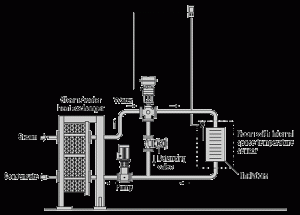 The theory behind temperature control and steam flow through a heat exchanger ( a term which includes air heating coils) is represented as Q= UxAxdT. In this expression, Q= flow; U = a fixed number, based on the conductivity of the tubes; A= the area of heat exchange; and dT is the temperature difference, or temperature rise through the heat exchanger. Thus, if we want to vary dT, we will need to modulate one of the other variables. In the most common application of steam coils and steam-to-water heat exchangers, steam flow, Q, is modulated to provide variation in temperature rise. This is often done with a steam control valve, much as is commonly seen in hydronic heat exchangers utilizing water as the medium of transfer. However, with steam we often run into a condition of coil stall, where at a certain position of the control valve we have reduced the flow and corresponding pressure to a point where we no longer have sufficient upstream pressure to move condensate back to the boiler. At this point, the condensate will back up into the heat exchanger and can result in numerous problems, from carbonic acid to freezing.
The theory behind temperature control and steam flow through a heat exchanger ( a term which includes air heating coils) is represented as Q= UxAxdT. In this expression, Q= flow; U = a fixed number, based on the conductivity of the tubes; A= the area of heat exchange; and dT is the temperature difference, or temperature rise through the heat exchanger. Thus, if we want to vary dT, we will need to modulate one of the other variables. In the most common application of steam coils and steam-to-water heat exchangers, steam flow, Q, is modulated to provide variation in temperature rise. This is often done with a steam control valve, much as is commonly seen in hydronic heat exchangers utilizing water as the medium of transfer. However, with steam we often run into a condition of coil stall, where at a certain position of the control valve we have reduced the flow and corresponding pressure to a point where we no longer have sufficient upstream pressure to move condensate back to the boiler. At this point, the condensate will back up into the heat exchanger and can result in numerous problems, from carbonic acid to freezing.
However, there are other approaches to temperature control that can deliver optimal performance without the resulting condensate problems. One of the best approaches is to reconsider the heat flow formula noted above. Rather than manipulating Q to control dT, one may consider manipulating A. Typically U is not an option since it is a fixed value. However, in steam systems it is entirely plausible to maintain steam flow, Q, at full flow/full pressure and vary the area that is exposed to exchange. This is exactly the formula used in the LJ Wing Integral Face and Bypass Coil. The same theory can be applied to steam-to-water heat exchangers and other processes utilizing steam as a heating medium.
It is worth considering temperature control options when designing the steam system, as the problems associated with poor or marginal design often outweigh the costs of a more creative approach. In many cases there are products available on the market. However, even when said products are not easily available, we can generally provide a design solution and/or custom product to do the job.
